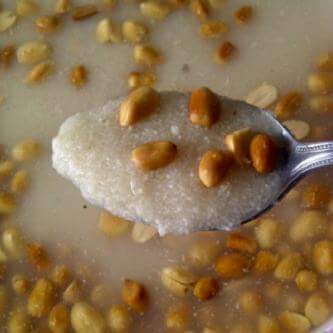Garri "Garion Sophate"
Garri also called "garion sophate" by the science students in Nigeria is used to describe any powdery material especially foodstuff. Flour grains e.g. Garin Dawa ( guinea corn flour),
Garin masara ( maize flour), Garin sukkhari ( sugar ). It can also be used for ground substances, as in Garin Magani (powdery medicine) by the Hausa Language Speakers.
It is a type of flour foodstuffs mixed with water used to be a major part of the diet in the Hausa lands and almost all parts of Nigeria for many centuries. It was used by travellers in particular, who were often unable to carry cooked meals. Traveling on horseback on donkeys and trekking took a very long time and so required readily-available fast food.
To make garri, cassava tubers are peeled, washed and grated or crushed to produce a mash. The mash could be mixed with palm oil (oil garri) before being placed in a porous bag. It is then placed in an adjustable press machine for 1–3 hours to remove excess starchy water. When the cassava has become dry enough, it is ready for the next step. [1] It is then sieved and fried in a large clay frying pot with or without palm oil. The resulting dry granular garri can be stored for long periods. It may be pounded or ground to make a fine flour.
Eba is a stiff dough made by soaking garri in hot water and kneading it with a wooden baton until it becomes a smooth doughy staple, that is served as part of a meal with various soups and sauces. Some of these include okra soup, egusi soup, vegetable soup, afang soup, banga soup and bitter leaf soup among others.
Kokoro is a common snack food in Nigeria, especially in southern and southeast Nigeria , especially Abia State, Rivers State, Anambra State , Enugu State and Imo State. It is made from a paste of maize flour, mixed with garri and sugar and deep-fried.
Garri comes in various consistencies, jodenwhich can roughly be categorized into rough, medium and smooth. Each type is used for a particular food.
As a snack , Cereal, or light meal, garri can be soaked in cold water (in which case it settles to the bottom), mixed with sugar or honey, and sometimes roasted Peanuts or groundnut with/or evaporated milk are sometimes added. The amount of water needed for soaked garri is 3:1. Garri can also be eaten dry without water, but with sugar and roasted peanut added.
In its dry form, garri is used as an accompaniment for soft cooked beans and palm oil. This food mix is called yoo ke garri or
Foto gari in the Ga language , in Ghana. Foto gari is the combination of moistened garri and stew, while yoo ke garri is garri with beans, a combination which is typically eaten as lunch. [1] It is also eaten with beans cake in Nigeria.
For a full meal, garri is usually cooked by adding it to hot water, then kneading it into dough. This is eaten with different types of thick, leafy vegetable stews, melon seed stews, peanut stews, or beans.
Smooth garri (known as lebu to the Yoruba) can be mixed with pepper and other spicy ingredients. A small amount of warm water and palm oil is added and mixed with the hand to soften up. This type of garri is served with fried fish. It is also served with frejon on Good Friday.
Variations In West Africa, there are two types, white and yellow garri. Yellow garri is prepared by frying with the addition of palm oil to give it a yellow colour; white garri is fried without palm oil.
Many variations of yellow and white garri are common across Nigeria. One variation of white garri is popularly known as garri-Ijebu. This is produced mainly by the Yoruba people of Ijebu origin.
In Ghana, garri is judged by its taste and grain size. The sweeter types with finer grains are more valued over sourer, large grain varieties. Commercial food vendors on the other hand prefer coarser grains with high starch content, as this yields more quantity when soaked in water. Buyers often look out for crispier grains when trying to determine freshness.
Consumption
Garri can be eaten without further cooking, as a snack, by placing it in a bowl and adding cold water. For example, ijebu-garri is made with finer grains, and has a pleasantly sour taste, making it very suitable to be eaten in this way. In most parts of West African, sugar or honey is then added as well as chunks of coconut, groundnuts , tiger nuts milk, and cashew nuts.
In most garri recipes it is cooked by adding boiling water and stirring to make a stiff paste or porridge. Among the Igbo people of Nigeria is known as utara, among Yoruba people as
eba or Teba in Northern Nigeria. Utara (or eba) is normally eaten with different kinds of
soups or stews . Most parts of Africa have an equivalent staple cassava dish.
In Liberia, Garri is used to make a dessert called Kanyan which is combined with peanuts and honey.
Concerns for health implications
Cassava, the root from which garri is produced, is rich in fiber, copper and magnesium. [3] Garri has so many health benefits, however, taking too much garri can have some health implications. Garri is made from cassava which contains hydrocyanic acid. Cyanide in garri, in large quantity, can lead to serious eye defects. However, proper and thorough processing of the garri should reduce the concentration of the acid to a considerate level. Cyanide is also an organic acid in nature and where in excess, can lead to intestinal issues, and can worsen the case of an ulcer patient.
Garri is also rich in carbohydrate. Hence, consuming much garri can lead to storing of excess carbs in the body and this can lead to unwanted weight gain.
https://en.m.wikipedia.org/wiki/Garri
